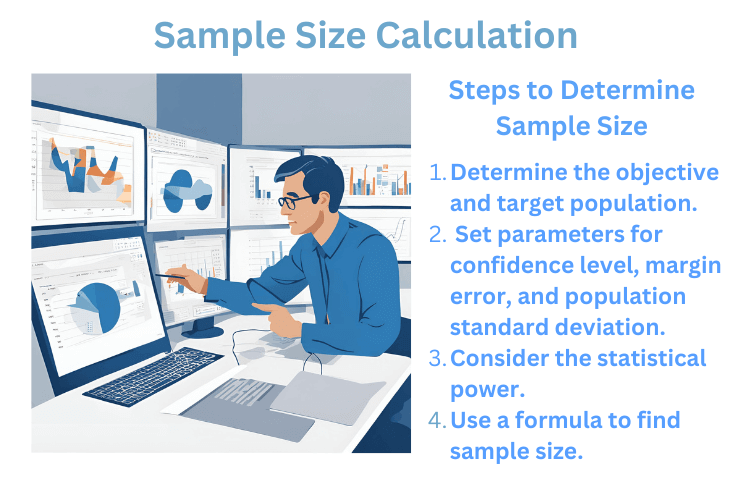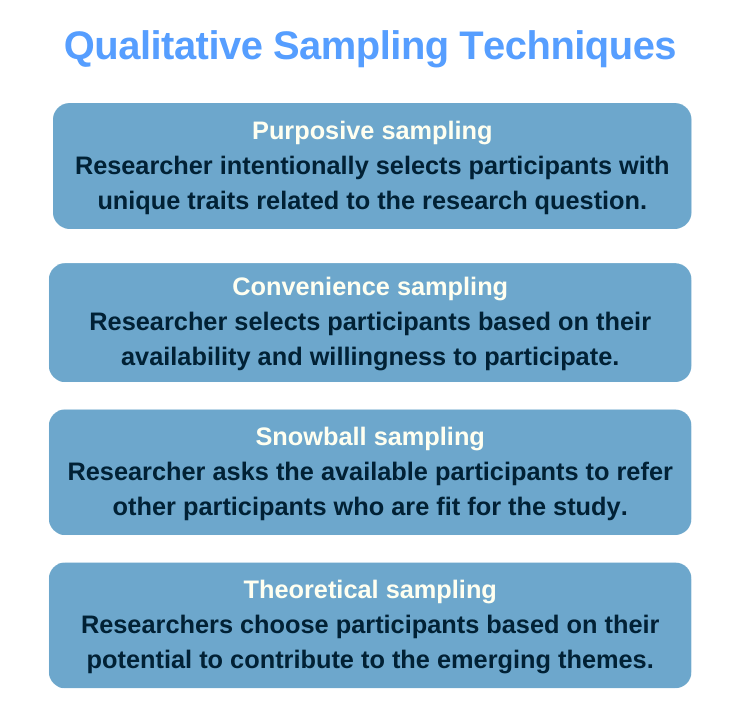Help Determine the Sample Size
In order to enhance the accuracy, reliability, validity, ethical and scientific integrity of research, it may be necessary for scholars and students to seek help to determine a sample size depending on the population size. For years, we have been helping students and scholars in determining a sample size that can truly represent the entire population of interest. We also help calculate statistical power as well as the significance level. The sample size calculation done by experts from our company is based on some of the factors discussed in this article.
There are different reasons for sample size calculation and use in survey research rather than directly involving each member of the target population. The reasons may be ethical, economic, or scientific. An undersized sample may be a waste of resources because of its possible inability to produce meaningful survey results; same with an oversized sample may yield results that are statistically significant but with a skeptical significance clinically. For these reasons, a successful survey should be founded on sampling that is influenced by various factors.
Factors We Consider When Determining Sample Size for a Study
Using an appropriate sample calculation formula, software, or equation, our experts assist in getting the right sample representative of the whole population under study, depending on the objectives of the research. After purchasing the services of a statistician for sample size calculation, our clients are assured of obtaining the most appropriate sample that leads to the achievement of the study objectives. The statistical power and impact of a study are greatly influenced by the sample size. We ensure that an optimum sample is determined scientifically for the study. Dealing with a larger sample size can be time-consuming, wasteful, and may raise ethical issues whereas a small sample size affects the study's effectiveness; thus, one must be sure to have the perfect sample size for their study. Some of the factors that we consider when hired to help determine the sample size for a study include:
(1). The objectives of sampling
In quantitative research and statistical methods of data analysis, people may conduct sampling with varying objectives. These include examining representative sub-sets of data to produce estimates of parameters of a particular population that can be closely related to the true values that could be obtained from a complete enumeration of all members; reducing operational costs, and minimization of computing and analytical requirements. Calculating sample size in research is essential in drawing conclusions that can be generalized to the entire population. We must, therefore, understand the objectives of the sampling process in order to customize our help to determine sample size appropriately.
(2). The type of sampling
There are two different types of sampling that can be used in studies, including probability and non-probability sampling. The probability sampling method entails giving each member of the target population an equal chance of participation, while in non-probability sampling, the selection of participants is based on some features of interest and convenience to the researcher. Before rendering help in sample size determination, one should strive to understand the types of sampling used to select participants and collect data to assess how much variance could exist between the sample and the true population size. A random sample minimizes the chances of bias and the margin of error in a study.
(3). Size of the population
The population size directly affects the decision to use sampling techniques in studies. A small population whose members can all be included in the study doesn't require sampling as opposed to large populations. We calculate the sample size to obtain a representative number of individuals whose characteristics reflect the true population to avoid the unnecessary costs of enumerating every member. The required sample size is relative to the population size or the number of survey responses presented for analysis.
(4). The cost of obtaining an appropriate sample size
Sample sizes differ with contexts, and the associated costs may affect the precision of the final estimates. When choosing sample sizes, it is imperative to be aware of the risk values. If the decisions that are to be made from sampling are extremely valuable, low-risk values are required; thus, larger sample sizes can be more applicable to the situation.
(6). Variability or spread of the target population
We use the sample size calculator to determine representative samples that form estimates of the specific characteristics of a population of interest. The sample size calculation done by experts from our company involves determining the variance of the estimate in proportion to the intrinsic variability of the population divided by the sample size. Multiple samples can be taken for a population whose variability is large.
(7). The practicality of the sample in comprehensive data collection
The sample size required must make sense in addressing the study question. We, therefore, provide help to determine an ideal sample size from which one can obtain precise estimates with regard to the population parameters of interest within a reasonable budget. We determine the sample size for a study after rationally quantifying the associated risks and costs. Our clients are assured of obtaining a perfect sample size with which they can achieve the objectives of the study satisfactorily using the allocated resources.
(8). The sample size statement
A sample size statement is fundamental because it states what is required or expected of the sample. It states what is being estimated, the level of precision required, and what is to be done with the final estimates. The sample size formula and equation help in determining the relationship between the desired level of precision for the estimate and the sample size. In case the equation contains unknown parameters of the population, such as the variance or mean; prior information from a previous study may be used to regulate the sample size through the use of prior mean and variance estimates. When we stratify the population to reduce variation, it is necessary to determine the sample size for each stratum.
(9). Sampling accuracy and precision
Sampling accuracy is a statistical indicator that is expressed in percentage as a relative index. It shows how close the sample-based parameter estimator is to the true population value. Sampling accuracy increases with the sample size. The precision in sampling relates to the variability of samples. The coefficient of variation index (CV) is used in determining the confidence level of estimates. We strive to ensure that the estimates are of high precision and accuracy depending on the subsequent use of statistical methods and the margin of error tolerable in the study.
(10). Study design
Study designs affect the sample size and the desired level of precision for estimates. Descriptive studies, including surveys and questionnaires, require larger sample sizes relative to analytical research. The number of samples also varies significantly between observational and experimental studies. Likewise, qualitative data outcome measures necessitate the use of more samples than quantitative data. Therefore, we understand it is fundamental to know the study design whenever hired to help determine the sample size that can be used to collect enough data to represent parameters for the overall population or an entire group of interest.
(11). Methods of sampling and sample size calculation
Other methods of determining sample sizes include tables, software packages, and monograms. Common statistical tables are used to determine sample sizes in different situations depending on efficacy, variability, and confidence levels. Monograms are also useful in determining sample size in studies based on effect size, confidence interval, and the population standard deviation. The G*Power software is the simplest method used to calculate the sample size for a study. The software uses target variance, the statistical test power, and confidence interval. Anyone wishing to hire a statistician to determine the sample size for their study can count on us for the best service.
Our experts understand the implications of different research designs and the common errors that may arise when using software such as R, SAS, Minitab, and Sample Size app, among other online tools, when calculating sample sizes.
(12). Outcome measures
The outcome measures such as the standard deviations, level of significance, statistical power, and effect size can be helpful when determining the sample size for a study. One can determine the standard deviation and effect size from previous research by examining literature or pilot studies where applicable. A small effect size is appropriately determined using a larger sample size. Although the significance level is fixed prior to the study, it is our responsibility to determine whether it is set at lower levels, thus, increasing the sample sizes.
(13). Confidence intervals and confidence levels
For every confidence interval or margin of error in statistics, there is a given confidence level associated with it. A confidence level helps in accounting for other potential sample results that could have been obtained using data from only one source to determine an estimate for a parameter of interest. We strictly comply with the Z-score for each of the most common confidence levels when using the Z-distribution to determine the total number of standard errors.
In our help to determine the sample size for a particular study, we calculate confidence intervals for multiple estimates such as proportions, population means, and variation among groups, depending on the context of the research question.
The above-discussed factors help in calculating the minimum sample size, the adjusted sample size, and the total sample size using the correct formulae. The sample size calculation done by experts from our company reflects the true proportion of the study population, and clients are assured of the precision and accuracy of the final estimates. Our services are available and accessible 24/7 and we comply with all the necessary terms agreed upon with the client. We are the ideal option for anyone wishing to hire a statistician to determine the sample size for their studies. Contact us today to make any inquiries and request a free quote.







